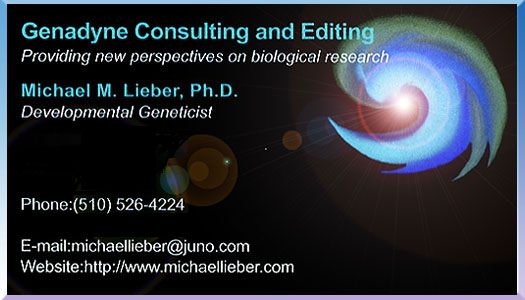Bacteriophage Research: Its Deeper Significance for Science
Dear Editors,
[Back]
Thank you for placing my recent article in Rivista di Biologia/Biology Forum (Lieber, [2006]) after Pennazioís article (Pennazio, [2006)], whose subject is the history of bacteriophage genetics. This placement symbolizes an important, extended history of the subject. The subject of my article is conceptually and historically connected to research that I undertook on the bacteriophage P1 in the context of a bacterial system. (See, for example, Lieber, [1989, 1990, 2000, 2001].) The results of this research were unusual, and unexpected, for the time, and indicated new ways of looking at mutagenesis and connected genomic behavior, with important relevance for the practice of recombinant-DNA technology and medicine. The concepts illustrated in my recent article about cancer were influenced by, and in many ways stemmed from, the explanations and theory used to give understanding of those very unusual phenomena involving bacteriophage P1.
In his article, Pennazio illustrated how research on bacteriophage contributed significantly to the development of molecular genetics, and to genetics in general. Nevertheless, my subsequent research on the effects of bacteriophage P1 on a bacterial genome, and indirectly research involving that very molecular genetics, led to the discovery of phenomena that could not be accounted for---except in a very limited way--- in terms of the explanations of molecular genetics. In effect, it showed that molecular explanations or models had limits in given situations. It defined those limits. Explanations in terms of molecular genetics, as I concluded, are very effective up to a certain boundary, and then another set of explanations or a model must take over. Both models or paradigms are valid in that they complement one another.
The history of genetics has examples where the established principles of genetics, though having explained much and having led to productive outcomes, yet, were shown to have their limits; they were productive or explanatory only up to a certain point, not accounting for all phenomena. Paramutation (Brink, [1956]), a genetic mutator process, is one such classical example of a phenomenon which violates---and thus cannot be explained by---one of Mendelís principles pertaining to allele association and segregation without allele modification. It demonstrates the limitation of the application of such a principle.
My own results, which demonstrated unusual mutator phenomena and which in many ways could not be explained using conventional concepts, met with much resistance. This was from those who would not or could not accept that explanations in terms of molecular genetics, though having proved very productive or effective so far, nevertheless had their limits or boundaries. Ironically, my own research with P1 was in a laboratory of a person who had studied with Luria, one of the founders of bacteriophage genetics and who had himself worked with P1 (e.g., Luria, [1960]). This person, unfortunately, was not pleased with my results, and I could not convince him otherwise.
Being at a later stage of bacteriophage research, my own research on the subject ironically demonstrated the boundaries of that very research. Yet, without the productive foundations of bacteriophage and bacterial genetics, the new phenomena would not have been observed. This group of related phenomena was not part of the intended research; it was not even anticipated or expected. The classical model of molecular genetics would not have predicted it; though, nevertheless, the experimental application of this model allowed for that phenomena to come into existence. In this situation, it would have been understandable why my colleague would not have been pleased. However, had he realized that within the old model there was the potential for a even more interesting, productive model or approach, he might have felt differently.
The moral of all this is that significant models or paradigms, such as molecular genetics, though effective in many areas and having been of merit over long periods, and well worth our praise, will necessarily lead to the discovery of phenomena that cannot be explained or understood in terms of those very models. By demonstrating, paradoxically, their limitations, they will necessarily give rise to or allow for new, more encompassing models of explanations, involving broader perspectives. Realizing this, should make us more tolerant as scientists, especially of our students, many of whom will most likely come across unusual phenomena. The history of science, which includes bacteriophage genetics, demonstrates the necessity of such tolerance. To do otherwise will put the progress of science in peril.
Michael M. Lieber
Genadyne Consulting
Berkeley, California 94707
E-mail: michaellieber@juno.com
References
Brink, R.A. [1956], A genetic change associated with the R locus in maize which is directed and potentially reversible. Genetics 41: 872-889.
Lieber, M. [1989], New developments on the generation of mutations in Escherichia coli lysogens. Acta Microbiologica Hungarica 36(4): 377-413.
Lieber, M. [1990], Mutagenesis as viewed from another perspective. Rivista di Biologia/Biology Forum 83(4): 513-522.
Lieber, M. [2000], Adaptively Responsive Hypermutation and its configurational-based regulation due to global position effect. Mutation Research, Fundamental and Molecular Mechanisms of Mutagenesis 449: 57-60.
Lieber, M. [2001], Temporal control of environmentally responsive hypermutation involving cryptic genes. Mutation Research, Fundamental and Molecular Mechanisms of Mutagenesis 473: 255-257.
Lieber, M. [2006], Towards an understanding of the role of forces in carcinogenesis: A perspective with therapeutic implications. Rivista di biologia/Biology Forum 99(1): 131-160.
Luria, S.E. et al. [1960], Transduction of linked genetic characters of the host by bacteriophage P1. Virology(1): 190-206.
Pennazio, S. [2006], The origin of phage virology. Rivista di Biologia/Biology Forum 99(1): 103-130.
home articles
bio

Plant Genomics & Developmental Biology Consultant / Expert Offering Creative
Paradigms for Scientific Advancement in Agriculture and Medicine, with Emphasis
on Plant Genetics / Genetic Engineering and Developmental Biology, e.g.,
Organogenesis. Michael M. Lieber, Ph.D. Berkeley, CA (510) 526-4224
MichaelLieber.com/Bacteriophage-Research.htm
(c) Michael M. Lieber, Genadyne Consulting
E-Mail: michaellieber@juno.com
Phone: (510) 526-4224
(c) Michael M. Lieber,
|